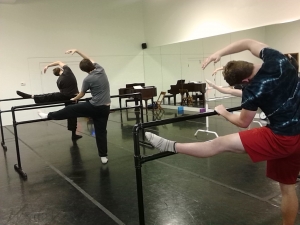You only have to watch the Olympics to see how the top gymnasts and ice skaters have supplemented their training with ballet lessons. The distinct use and carriage of the arms and hands as well as the line of the legs is foundational to classical ballet. Ballet is the foundation of all dance forms and is the only technique that can give this iconic way of moving.
The Today show – “In Russia, ballet is key for Olympic figure skaters: Olympic correspondent Mary Carillo looks into the deep connection Russia has with ballet and how figure skaters with Olympic dreams utilize the discipline for their training.”
In gymnastics and ice skating, it is obvious that ballet training is necessary if you are serious about attaining a high level of excellence but did you know that it is just as important for football players as well?!
The following article is taken from livestrong.com/article/52494
Can ballet improve your football?
The skills required to master the game of football include strength, flexibility, agility and mental preparedness. Many football players exhibit strength, but may be lacking in other areas. This is where ballet enters in. Ballet lessons can improve your strength, increase flexibility and make you more agile, while providing a mind-body connection and reducing your risk of injury.
Strength
Strength is a key component of playing football. If you are not strong, you will not have much success in the game. Ballet provides a total body workout that targets muscles few other exercises use. For instance, ballet strengthens the muscles in your feet. Ballet lessons will additionally strengthen your back, legs and arms, with a great emphasis on strengthening your core muscles, which are useful while playing football. Working a variety of different muscles makes your muscles more adaptable, according to American Academy of Orthopaedic Surgeons.
Side note: As large as they are, football players often lack strength in a few key areas. Ballet exercises help strengthen muscles that are not typically targeted in a weight room. In particular working in a turned out position, with the legs rotated outward at the hips, will help to strengthen smaller, injury-prone muscles beneath the glutes and around the pelvis. Working on the balls of the feet, as ballet dancers do, requires engagement of the core, calves, ankles and feet, which can improve balance and stability when rushing, pivoting and dodging.
Flexibility
Being flexible may not seem like a key factor in football, but increased flexibility has many benefits to the game. Ballet provided the flexibility necessary for NFL Hall of Famer Lynn Swann to become famous for his graceful, entertaining and successful football career. Increased flexibility can also reduce your risk of injuries, according to the National Institute of Arthritis and Musculoskeletal and Skin Diseases.
Side note: When dancers perform demi-pliés, relevés and tendus — exercises that involve bending the knees, rising onto the toes and brushing the feet along the floor — they loosen up their knees, ankles and feet, which translates to greater agility in sports. Ballet exercises such as battement and grand plié – or kicks and deep knee bends — lengthen leg muscles and increase hip flexibility, which lowers the risk of injury. John A. Bergfeld, medical advisor for the Cleveland Browns, saw fewer groin strain injuries after team members participated in a 12-week series of ballet classes. Bergfeld claims ballet leads to heightened body awareness and increased hip joint range of motion, factors that can help prevent groin strain.
Additional Physical Benefits
In addition to making you a stronger, more flexible football player, ballet can make you more agile, moving quickly on your feet, changing directions with greater balance, stability and a greater range of motion. Ballet can also help increase your speed, as it did with Dallas Cowboys running back Herschel Walker. Walker credits his speed and agility to his diverse exercise routine that included ballet.
Mental Benefits
One of the most important components of playing football is concentration, another benefit Walker credits to his ballet experience. Dance lowers your stress, stimulates you intellectually and helps you recognize and deal with patterns, spacial issues and sequences, which are essential to football strategy. Dance also trains you to perform in front of an audience, an aspect that can frighten athletes into poor operation at game time. Dance stimulates a connection between your brain and your body that helps you do your best in all activities, including football.
Precision and Control
Ballet places a heavy emphasis on precision, or proper placement of the head, arms, hands, legs and feet. Gaining more control over the body and aiming for physical precision helps football players develop greater self-control and self-discipline on the field. When working at a ballet barre, students must remain in-tune with every muscle. When they proceed into the center of the room, where they perform more complex movement combinations, dancers develop quick, sharp minds and fast footwork. They learn to transfer their weight effortlessly and find their new center of balance instantly, skills that translate into quick and accurate starts and stops on the playing field.
